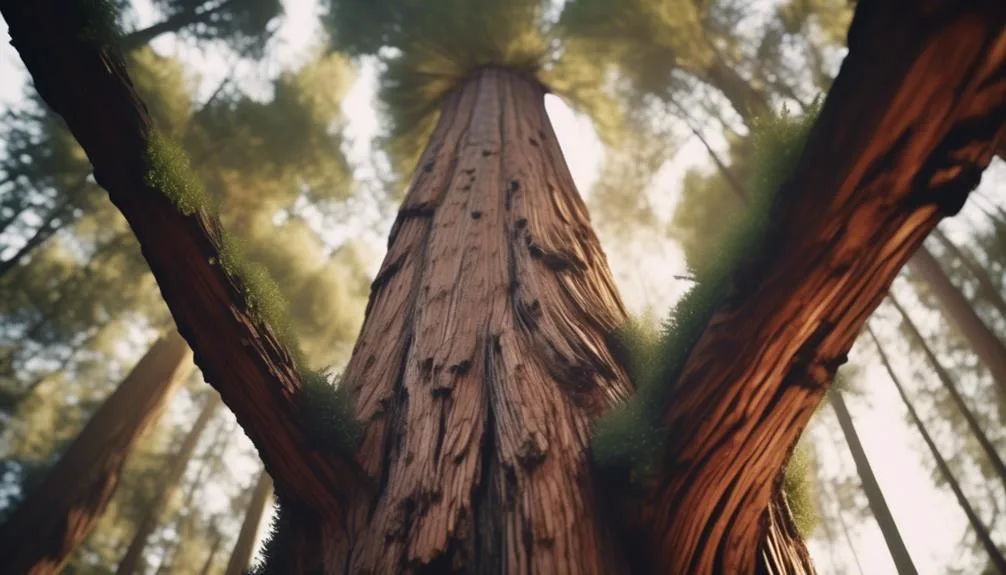Redwood trees can be grafted, which has captured the interest of many tree experts. This process allows the creation of unique and strong redwood hybrids, offering new possibilities for enthusiasts and researchers.
How is it done, and what factors affect its success? We'll explore the feasibility, methods, suitable varieties, and care tips for grafted redwood trees.
Stay tuned for an intriguing look into this fascinating practice.
Grafting Redwood Trees: Feasibility
Grafting redwood trees isn't only feasible but also offers a promising method for propagating desirable traits in these majestic giants. The process involves joining a scion, or a shoot with desirable traits, onto a rootstock, creating a new tree with combined beneficial characteristics.
Grafting techniques present challenges due to the redwood tree's genetic diversity, as it can lead to compatibility issues between the scion and rootstock. However, overcoming these challenges can result in numerous benefits, such as the ability to propagate specific traits like disease resistance or faster growth.
Additionally, grafting allows for the preservation of unique redwood varieties that may be endangered or threatened in their natural habitat. Exploring grafting methods for redwood trees holds potential for enhancing and preserving the genetic diversity of these iconic and ecologically significant species.
Methodology for Grafting Redwood Trees
With a careful selection of scion and rootstock, you can begin the process of grafting redwood trees to propagate specific traits and preserve endangered varieties. Grafting techniques for redwood trees include cleft grafting, bark grafting, and whip and tongue grafting.
When selecting scion wood, choose healthy, disease-free branches from the desired redwood variety. The rootstock should be a young, vigorous redwood seedling with a diameter similar to the scion. It's crucial to ensure that the cambium layers of the scion and rootstock are aligned to promote successful union.
Understanding tree genetics is essential to ensure compatibility between the scion and rootstock, increasing the likelihood of a successful graft.
Proper care and monitoring post-grafting are vital for the graft to heal and grow seamlessly, ultimately preserving the genetic diversity of redwood trees.
Suitable Redwood Tree Varieties for Grafting
Preserving the genetic diversity of redwood trees through grafting involves selecting suitable varieties with specific traits for propagation. When considering suitable redwood tree varieties for grafting, it's crucial to focus on factors such as compatibility, growth rate, and disease resistance.
Coastal redwoods (Sequoia sempervirens) and giant sequoias (Sequoiadendron giganteum) are popular choices for grafting due to their desirable characteristics. These varieties are known for their rapid growth, impressive size, and adaptability to different soil types. Additionally, they exhibit strong resistance to common pests and diseases, making them ideal candidates for successful grafting.
Factors Affecting Redwood Tree Grafting Success
To ensure successful grafting of redwood trees, understanding the key factors that influence the process is essential for achieving the desired results. Grafting techniques play a crucial role in determining the success of redwood tree grafting. The method used, whether it's whip and tongue grafting, side veneer grafting, or approach grafting, can significantly impact the overall success rate. Each technique requires precision and skill to ensure proper cambium alignment and union formation.
Moreover, environmental conditions also play a vital role in the success of redwood tree grafting. Factors such as temperature, humidity, and light exposure can affect the healing process and overall graft success. It's important to create an environment that promotes healing and minimizes stress on the grafted trees.
Care and Maintenance of Grafted Redwood Trees
Proper care and maintenance of grafted redwood trees is crucial to ensure their continued growth and vitality. To keep your grafted redwood trees healthy and thriving, consider the following:
- Watering Schedule:
- Water deeply and infrequently, allowing the soil to dry out slightly between waterings to encourage deep root growth.
- During hot and dry periods, increase the frequency of watering to prevent stress on the tree.
- Pruning Techniques:
- Regularly inspect the tree for any dead or diseased branches, and promptly prune them to maintain tree health.
- Use clean, sharp tools to make precise cuts, and avoid over-pruning to maintain the tree's natural shape and structure.
Conclusion
Successfully grafting redwood trees requires meticulous attention to methodology, tree compatibility, timing, and aftercare. With proper care, grafted redwood trees can flourish and showcase desired characteristics.
For those passionate about horticulture, the art of grafting redwood trees presents a rewarding and captivating pursuit.
Mark Hoffman is a dedicated arborist and tree care specialist with over a decade of experience. His love for trees began when he visited Yosemite National Park as a teenager and was awestruck by the giant sequoias. Mark pursued his passion by studying forestry at Michigan Technological University, where he earned a Bachelor of Science degree.
Since then, he has worked tirelessly in the field of arboriculture, helping to preserve and protect trees in his community. His expertise and dedication have made him a respected leader in the industry and a valuable resource for anyone seeking advice on tree care.
